► Audi’s entry-level touring car racer tested
► On track at the spectacular Road Atlanta circuit
► New breed of TCR touring car racers explained
The air at Georgia’s Road Atlanta race circuit is like a wet, warm blanket. It’s a couple of sunrises after the spectacular Petit Le Mans race and what was a bustling hive of spectators and race teams is drowsy calmness.
Until now. A rasping sound echoes through the tall trees as a squat, black-’n’-red race car in Audi Sport livery rumbles out of the pitlane; an Audi RS3 LMS touring car is heading out on track for some warm-up laps. And it’s our turn next.
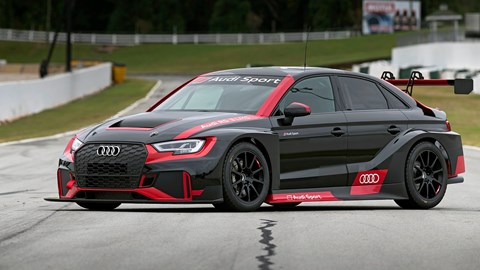
What exactly is the Audi RS3 LMS?
Audi Sport’s entry-point into the world of touring car racing, built to be sold to customer race teams and individuals.
If you’re a serious team planning a TCR championship campaign, or have designs on being the fastest moving object at any given trackday, you fit into its target market.
More acronyms… What is TCR?
It’s the formula the RS3 LMS has been principally built to compete in. The name stands for Touring Car Racing, logically enough, and a couple of years ago it was the next big thing in Touring Cars; now it is the big thing.

A global formula geared around (relatively) low-cost technical regulations, since its first season in 2015 it’s taken off around the world with various national and international championships adopting its rules, including the former World Touring Car Championship (WTCC), which has morphed into the WTCR for 2018. A UK TCR series runs for the first time in 2018.
TCR cars are more production-based than those used in the British Touring Car Championship (BTCC), particularly in terms of their engines. All cars are front-wheel-drive, and must use a four- or five-door shell.
Most TCR cars cost around €100k, and about the same in terms of running costs for a season’s racing – reckon on double that for a middling BTCC budget.
What’s it like inside?
Step over the giant extended sills like a sideways version of John Cleese in his Ministry of Silly Walks sketch, then fold yourself through the rollcage into the solitary seat, set so far back within the shell for weight distribution you almost feel it would have been easier to access it via the rear door instead.

Where the passenger seat would be you’ll find a race-spec battery, and in the centre of the cabin there’s a giant aluminium wand, looking like something Ken Block might use to flick his Gymkhana car sideways. It actually is a handbrake of sorts, linked straight to the rear brakes, but it’s not there to pull extreme handbrake turns.
‘That’s unless you’re [international TCR champion driver] Stefano Comini at the Macau street circuit – he uses it to get round the tight hairpins,’ the car’s regular driver Paul Holton tells me. Instead, the lever is there to hold the car on sloping grids, and can also be used to help warm the rear tyres on warm-up laps. ‘Ease into it, though, don’t pull it too hard in case you lock the rears,’ Holton advises.
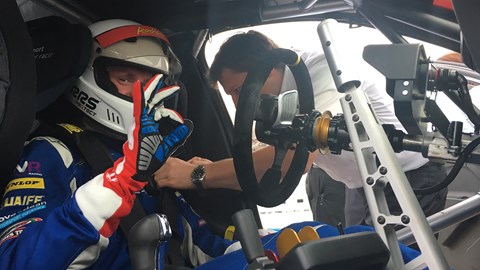
I make a mental note in ink; performing a handbrake turn into the nearest barrier on the warm-up lap isn’t something I’m keen on doing. Holton won the 2017 TCR class championship in the USA’s Pirelli World Challenge, which rounded off a successful debut season for the RS3 LMS around the world; it won its class in the very first race it entered at the year’s start, the Dubai 24h.
Give me a tech overview…
Who doesn’t love a car with box arches? Think Audi Ur-Quattro, Lancia Delta Integrale, Metro 6R4, rally-spec Mk2 Escort – and now, the Audi RS3 LMS touring car joins the list of competition cars that are hip ’cos they’re square.
Somewhere within bodywork extensions blockier than the characters in Dire Straits’ Money For Nothing video there’s the basic shell from the A3/S3/RS3 saloon. The engine is very much production-based, the same EA888 turbocharged four-cylinder you’ll find in all sorts of VW Group performance cars, from Golf GTI to Skoda Octavia vRS and Seat Leon Cupra, only real changes being a different intercooler and crankcase, and a rejigged intake and cooling system. In the RS3 LMS it’s available in four different power outputs from around 290 to 350bhp depending on local series’ regulations and customers’ requirements.
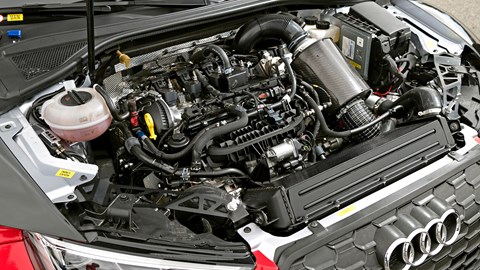
The RS3 road car uses a charismatic 400bhp 2.5-litre five-cylinder, but that wouldn’t be allowed in TCR racing, which focuses on 2.0-litre four-pots. Likewise, the road car’s quattro all-wheel-drive would be too naughty for TCR, so it’s front-drive instead.
A quick-fill FIA-spec safety fuel cell resides where you’d usually find the rear seats. The road car’s fuel flap now covers the socket for the built-in air jacks; to tank it up with petrol you’ll need to open the rear door. There’s a fuel gauge tacked onto the rollcage nearby so team-members can quickly check – a neat touch.

Beneath the giant rear wing the boot lid is steel, and those box arches are fibreglass, to save money when they inevitably get bashed. Touring car drivers tend to get fairly tactile with one another on track.
Suspension-wise, the location points are all the same, albeit with bespoke control arms, and a ton of camber to go with the widescreen track widths, the wheels adopting that serious-race-car diagonal stance within the arch shrouds.
‘These things are turn-in bandits’, Audi Sport’s Brad Kettler says. ‘We run it in quite a numb setting for customers testing the car for the first time, and run less camber, around 4 degrees. It’s usually 5 deg. A lot of guys come in and say ‘are you sure this is front-wheel-drive?’
Start it up!
Flick the red main switch, then the yellow ignition and thumb the starter button on the steering wheel. It sounds seriously butch for a four-cylinder, rumbling through its centre exhaust. A whole field of these things must make a right din. It’s louder Audi’s R8 GT4 car, in fact.
A full race-spec sequential gearbox is available, but entry-level versions come with a dual-clutch ‘S-tronic’ production gearbox, just like you’d find in an S3 road car – leather-gaited gear lever and all. In fact, you could even race it in auto mode if you like. ‘It’s got quite an aggressive downshift map, and some new drivers actually find they’re quicker in auto mode than if they use the paddles,’ Kettler says.

So setting off is as simple as popping the lever in ‘D’ (then nudging it across to manual mode, if you want to use the metal shift paddles fixed to the back of the steering wheel), taking your foot off the brake and going for a drive.
Turn One is a dauntingly fast right-hander, first page in the non-stop thriller that is Road Atlanta, one of the most exciting, flowing circuits I’ve driven. It’s a track from the old school, an undulating rollercoaster of blind crests, high corner speeds and solid things to hit if you find yourself paying a visit to any of its not-particularly-generous run-off areas.
Pro Audi Sport driver Pierre Kaffer took me for a sighting lap in an RS3 road car to show me the circuit earlier that morning (the car always perfectly balanced, one hand on the wheel to point out reference points, while chatting about how he learned the circuit under slightly more pressure in an Audi R8 LMP1 Le Mans car), and explained how the run to the final corner is up a curving crest so steep you must turn the wheel before you can actually see where you’re going. The don’t make tracks like this anymore – more’s the pity.
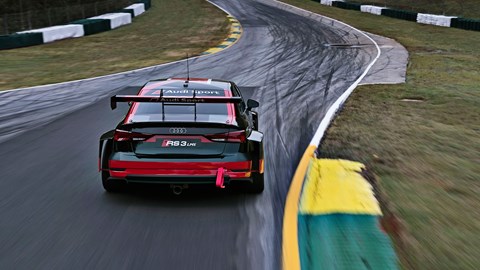
Some people have a phobia of spiders; mine is cold rear slicks on front-wheel-drive racing cars. The front tyres heat up quickly, but the rears have a tendency to stay cool, so on the first lap I progressively haul on the hand brake lever to build heat in the rear brakes and in turn the rear tyres. On lap two, it already feels hugely grippy and neutral.
The RS3 LMS shares a lot of technical DNA with the Audi TT cup car I raced at Hockenheim in 2017 (it even has the same steering wheel and dash display), but it feels more forgiving, less unpredictable. Holton, himself a graduate of the TT Cup, agrees: ‘Compared to the TT, it’s more stable, and you can trail the brakes more to rotate the car. The downforce starts working from as little as 70mph. It can actually roll about 10mph more into Turn One at Road Atlanta than GT4 cars.’ [Holton set a GT4 lap record for Road Atlanta in a McLaren in 2017].
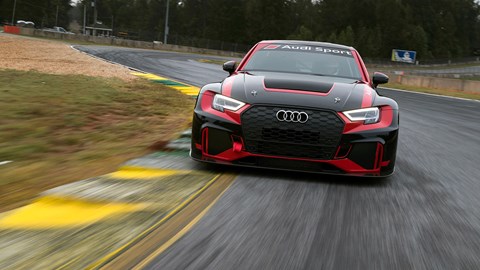
Out of interest, for one lap I stop using the shift paddles and swap to auto mode, and it really does work surprisingly well. Although this car’s purpose in life is to be a racing car first and foremost, Audi USA say they’ve had a fair amount of interest from trackday customers, and as a recreational toy it would make sense – it would outrun any supercar and never run out of brakes, no matter how many laps you do.
It’s an entertaining thing to drive, its suspension with enough travel and control to take advantage of Road Atlanta’s kerbs, its non-assisted brakes seriously powerful, and it doesn’t seem to have heard of understeer. Great fun.
Why is it based on the RS3 saloon instead of the Sportback hatch?
It’s not for aero advantages, but to stir up interest in the RS3 road car in further flung markets.
‘It was a decision for global marketing reasons,’ explains Chris Reinke, head of Audi Sport’s customer racing division. ‘We chose the sedan shape on purpose to vary our promotion for different markets. To be honest we had to persuade the board [that it was the right decision] – but if you look around the world to USA and Asia, a limousine shape is more popular than a hatchback [and the wider VW Group already has five-door cars represented in TCR by the Golf and the Seat Leon]. It’s given us a unique silhouette, which makes the car stand out on track – so a potential loss [of coverage] in Europe, which we would have accepted, hasn’t actually happened.’
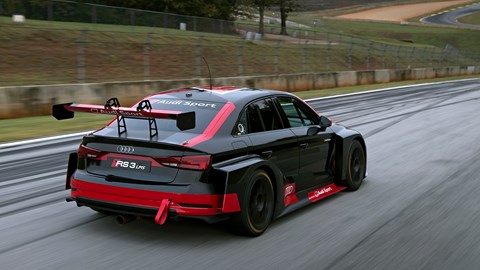
The RS3 LMS has a fair bit in common with the aforementioned VW Golf TCR and Seat Leon Cup cars – which themselves had their design informed by the development of the Audi Sport TT cup car.
‘Development of the RS3 LMS went via the TT cup car – it’s a very similar car and we know exactly its strengths and weaknesses’, Reinke says.
The RS3 LMS cars are built at Seat’s Martorell factory, as are the Leon and Golf TCR cars. ‘We can bring one VW Group parts supplier track to the track, which means lower running costs,’ Reinke says.
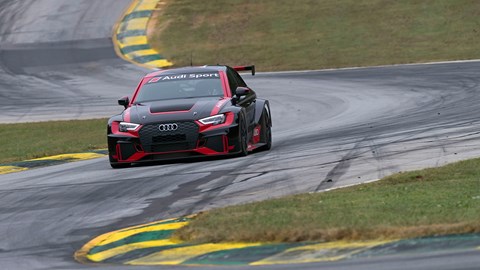
The business case seems compelling: in the latter part of 2017 Audi had sold enough RS3 LMS cars as to be well into triple figures, with 120 cars already in the hands of customers.
‘First we made an investigation into the volume of the market,’ says Chris Reinke. ‘At the moment the market is big, and it could expand; Japan is looking at TCR racing, there is growth in China, Korea is investigating – all potential markets [for Audi to expand within]. We can showcase the brand to markets where we have not before.’
The RS3 LMS is one of three Customer Racing cars Audi Sport sells, together with the R8 LMS GT3 and R8 LMS GT4 (below) that compete in global GT racing.

(Incidentally, LMS sounds like it’s something to do with Le Mans, but actually stands for something that doesn’t quite make sense in German, and is the label applied to most of Audi’s customer race cars.)
What kind of competition is Audi’s RS3 up against?
It’s a C-segment formula – dimensional restrictions preclude smaller cars like Minis and current TCR cars include the Honda Civic, Seat Leon, VW Golf, Alfa Giulietta and Opel (Vauxhall) Astra, while Hyundai has recently signed up to the formula with a TCR car to promote its new i30 N hot hatch.
However, there are no factory teams as such – the whole point of TCR is that it’s a customer series.
How much is the Audi RS3 LMS?
To get it in ‘Clubsport’ trim as the ultimate track day car, you’re looking at approx. €99,000 (£86k) before taxes, with a racing diff but DSG production gearbox. For full-on TCR touring car racing spec with a sequential gearbox, it’ll be roughly €129k (£113k), depending on local taxes.
It’s a riot to drive in isolation. Imagine doing it with 20+ other cars going for the same piece of tarmac…
Words by James Taylor
Photography by Bodo Kräling